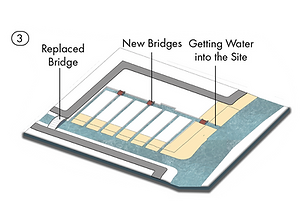
SCHOOL IN THE MARSHES
(Competition)
Prize Achieved: Honourable Mention
Project Location: Iraqi Marshes
Team: Ömer Varol - İbrahim Nart
Submission Date: 28.08.2018
Competition Website: Here
Project Code: DA1-137
Illustration by Ömer Varol
Participants were asked to design a primary school in the long-forgotten area of the Iraqi marshes, taking into account the limitations of the site and the cultural impact of construction on local people of the marshes. The design is for a 6 class primary school serving the nearby villages with all the amenities of a modern school.
THE CONTEXT: A TYPICAL MARSHLAND OF IRAQ

The Iraqi Marshes, listed as UNESCO Heritage Site in 2006, are a wetland area located in southern Iraq. Historically the marshlands used to be the largest wetland ecosystem of Western Eurasia. A Typical Marsh Landscape: Villages are built on artificial floating islands by enclosing a piece of swamp and filling it in with reeds and mud. For flood protection, more layers are added each year to strengthen the platform’s foundation.

LOCAL CONSTRUCTION AND MATERIALS
‘Mudhif’ is one of the essential cultural elements in the region. It is where all people gather, spend time, even solve disputes between families. In this sense, mudhifs can be called as local cultural centres of the region. Typically, a mudhif is a seven-row arch structure covered with weaved woods. Reeds are used to constitute the main arches which is a prevalent way of construction in the region.



Weaved Wood (Local Craft)
Reeds of the Marshland
Construction with Local Crafts
RESPONSE
The proposed plot (15,000 m2) can be accessed through rural roads which connect it with the surrounding villages. The easiest way to reach the site is by using the traditional boat “Mashoof”. Lack of services, including educational facilities has caused the residents to leave the area; as the nearest school is no less than 3 km away. Consequently, the project is aimed to be an attracting centre for the local people to re-gather in their own regions and preserve their cultures by connecting with the educational and cultural facilities.
The main problem is defined and transformed into a question, which is:
“How an educational building can be interpreted as a unit for interchanging, preserving and improving the local culture, but most importantly, ensuring that the local people could develop a sense of belonging?”
WATER AS A CONNECTOR MORE THAN A SEPERATOR
The layout plan is inspired by the floating islands of marshes. In this system, water is used as a connector more than a separator by getting water inside the plot area.

Water as a Connector

Social sustainability is vital especially for this kind of projects. Therefore, this school is thought not only for educating the children but also for the local people. Education units such as handcraft workplaces are proposed to ensure the continuity of the unique cultural elements.










